League of Communists of Yugoslavia
The League of Communists of Yugoslavia (Serbo-Croatian: Savez komunista Jugoslavije / Савез комуниста Југославије),[lower-alpha 1] known until 1952 as the Communist Party of Yugoslavia,[lower-alpha 2] was the founding and ruling party of SFR Yugoslavia. It was formed in 1919 as the main communist opposition party in the Kingdom of Serbs, Croats and Slovenes and after its initial successes in the elections, it was proscribed by the royal government and was at times harshly and violently suppressed. It remained an illegal underground group until World War II when, after the Invasion of Yugoslavia in 1941, the military arm of the party, the Yugoslav Partisans, became embroiled in a bloody civil war and defeated the Axis powers and their local auxiliaries. After the liberation from foreign occupation in 1945, the party consolidated its power and established a one-party state, which existed until the 1990 breakup of Yugoslavia.
The party, which was led by Josip Broz Tito from 1937 to 1980, was the first communist party in power in the history of the Eastern Bloc that openly opposed the Soviet Union and thus was expelled from the Cominform in 1948 in what is known as the Tito–Stalin split. After internal purges of pro-Soviet members, the party renamed itself the League of Communists in 1952 and adopted the politics of workers' self-management and independent communism, known as Titoism.
Opposition party
Establishment
.JPG.webp)
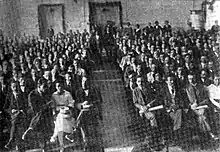
-Beograd.jpg.webp)

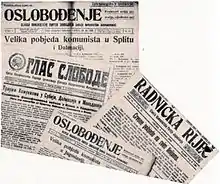

The Kingdom of Serbs, Croats and Slovenes (later renamed Yugoslavia) was established in late 1918 at the end of the World War I.[2] Socialist movement in the territory of the new state reflected political divisions existing before the war. For example, in what was then Austria-Hungary, the Social Democratic Party of Croatia and Slavonia (SDPCS) came into existence in 1894, two years before the Yugoslav Social-Democratic Party (Jugoslovanska socialdemokratska stranka, JSDS) was set up in Slovene Lands. The Serbian Social Democratic Party (SSDP) was founded in 1903.[3] In Bosnia and Herzegovina, the Social Democratic Party of Bosnia and Herzegovina (SDPBH) was established.[4]
The SSDP deemed it natural to serve, as the largest social-democratic party in the new state, to unify like-minded political groups in the country. The SDPBH formally proposed a merger of such parties, but the SDPCS, the JSDS, and Serbian–Bunjevac social-democrats from Vojvodina declined. In turn, only the SSDP and the SDPBH formally agreed to a merger by January 1919. A minority group on the left wing of the SDPCS split from the party as the Action Committee of the Left (Akcioni odbor ljevice) and opted for the unified social-democratic party with the SSDP and the SDPBH. Soon afterwards, the Vojvodina social-democrats reversed their decision.[5] The Unification congress of the Socialist Labor Party of Yugoslavia (Communist) (Socijalistička radnička partija Jugoslavije (komunista), SRPJ(k)) was held in Belgrade on 20–23 April 1919 as consolidation on the left of the political spectrum. The new party was joined by the SSDP en masse, and by independent leftists who splintered away from various nationalist youth organisations and social democratic parties.[6] The Labour Socialist Party of Slovenia (Delavska socialistična stranka za Slovenijo) split from the JSDS and joined the SRPJ(k) on 13 April 1920.[7]
Clashes continued within the party between leftists and centrists – the latter favouring pursuit of reforms through a parliamentary system. The leftist faction prevailed at the second congress held in Vukovar on 20–24 June 1920 and adopted a new statute.[8] That aligned the party entirely with the Communist International (Comintern),[9] implementing all instructions received from the Comintern.[10] Furthermore, the party was renamed the Communist Party of Yugoslavia (Komunistička partija Jugoslavije, KPJ) to allow its membership in the Comintern.[11] Filip Filipović and Sima Marković, both former SSDP activists, were elected to lead the KPJ. By May 1920, the KPJ had about 50,000 members,[12] and numerous sympathisers largely drawn from among 300,000 members of trade unions and youth organisations.[13]
1920 Elections and ban
In the 1920 Constitutional Assembly election, the KPJ won 58 out of 419 seats.[14] The best results were achieved in large cities, in Montenegro and Macedonia as a result of protest votes against the regime on account of past or expected actions coming from unemployed urban voters and from voters in regions having no other attractive national or regional opposition parties found in the Slovene lands, Croatia-Slavonia, and Bosnia and Herzegovina.[15] In light of difficult economic and social circumstances, the regime viewed the KPJ as the main threat to the system of government.[11] In response to the KPJ’s electoral success at the local and regional level including Belgrade and Zagreb earlier that year in March–August,[16] and at the national level the Democratic Party and the People's Radical Party advocated prohibition of Communist activity.[15]
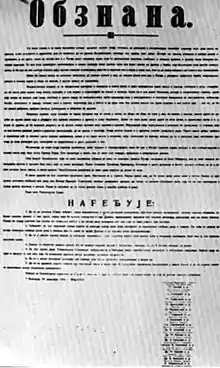
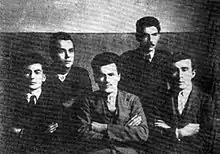
In December 1920, KPJ-led miner strikes in Slovenia and Bosnia and Herzegovina led to suppression by the royal army and restrictions on Communist propaganda.[17] On 30 December, the government issued a Proclamation (Obznana) outlawing the KPJ. A faction of the KPJ named Red Justice (Crvena pravda) attempted to assassinate the Regent Alexander on 28 June, and then killed former Interior Minister Milorad Drašković on 21 July. This led to proclamation of the Law on the Protection of the Realm turning the KPJ ban into legislation on 2 August, annulment of the KPJ seats in the national assembly two days later, and numerous covert police agents infiltrating the KPJ.[16][17]
Move abroad and underground
Despite the electoral success, the ban and KPJ’s consequent move to covert operation took a heavy toll on the party in the next decade and a half when, faced with factional struggle, it would increasingly look to the Comintern for guidance.[18] By 1924, the KPJ membership was reduced to 688.[17] Additionally, some members emigrated abroad – most to Moscow, but also to Vienna, Prague, and Paris.[19] Indeed, the KPJ held a land conference in Vienna in 1922,[20] where the party leadership moved the year before.[21]
In early 1920s, KPJ saw more factional struggle between its right wing led by Marković and Belgrade-based trade union leaders Lazar Stefanović and Života Milojković advocating work through legal means to regain government approval, and leftists, including Đuro Cvijić, Vladimir Ćopić, Triša Kaclerović, Rajko Jovanović, and Kosta Novaković, favouring Leninist undercover struggle. The leftists also supported a federalisation of the state, while the others pushed for limited regional autonomy only.[22][23]
The leftists prevailed at the January 1924 Third Land Conference held covertly in Belgrade where the KPJ proclaimed the right of each nation to secede and form its national state. In June, the Comintern instructed the KPJ that self-determination should take shape of independent Slovenian, Croatian, and Macedonian republics. The stance taken by the Cominform was influenced by Moscow visit by Stjepan Radić, the leader of the Croatian Peasant Party (Hrvatska seljačka stranka, HSS) when Radić added the HSS to the Peasant International (Krestintern) – itself an agency of the Cominform.[24]
Furthermore, the Comintern criticised the factional clashes in the KPJ over the national question in its 1924 Resolution of National Question which linked social emancipation to national one in strategic considerations.[25] In response, Milojković was expelled, but Marković remained a part of KPJ leadership. This changed in 1925 when he was denounced by the leader of the Soviet Union Joseph Stalin personally before Yugoslav commission of the Comintern insisting that the KPJ must harness national movements for revolutionary aims. Regardless, the factional struggle continued.[26] In 1927, the seat of the KPJ central committee in Yugoslavia was moved from Belgrade to Zagreb.[27]
Leftists prevail
In February 1928, Josip Broz Tito and Andrija Hebrang, seeking to stir the existing situation into resolution of the conflict, persuaded the delegates to conference of the Zagreb KPJ organisation to adopt a resolution seeking the Comintern to intervene and end the factional struggle in the KPJ entirely.[28] The KPJ also led some of street protests in Croatia over assassination of Radić later that year. The Comintern Sixth World Congress held that year sought to increase revolutionary struggle and the strategy was accepted by the KPJ at its Fourth Congress held in Dresden in October 1928. The appeal made at the initiative of Tito and Hebrang was accepted: Marković was expelled and his allies demoted, while new leadership was installed. Tito and Hebrang were bypassed because they were just imprisoned in Yugoslavia, and Đuro Salaj, Žika Pecarski, and Đuro Đaković were appointed instead as entirely Comintern-trained leadership.[29]
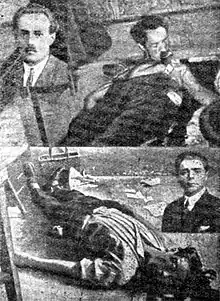
In 1929, the new KPJ leadership put the Comintern’s call to violence into practice, but instead of all-out revolt, the efforts were consisted of leaflets and several shoot-outs with the police.[30] KPJ losses were heavy and included death of several significant leaders including Đaković and imprisonment of its most active members by specially convened antisubversive tribunals. In turn, the Sremska Mitrovica Prison became a makeshift KPJ training school as the prison allowed grouping of political prisoners.[31]
On instructions from the Comintern, non-Serb members of the KPJ were to advocate breakup of Yugoslavia as a construct of the Western Powers. However at the time, most of their efforts were invested in struggle against the JSDS and debating revolutionary merits of literature written by Miroslav Krleža. By 1932, membership dwindled to less than 500,[30] the KPJ maintained its leadership divided in at least two locations at all times in 1928–1935, including at least one abroad in Moscow, Prague, Vienna, or Paris.[31]
Also acting on Comintern July 1932 instructions to promote and aid national revolt in Croatia, Slovenia, Montenegro, and Macedonia, the KPJ sought to establish ties with the Bulgaria-based Internal Macedonian Revolutionary Organization, but the organisation was suffering from its internal weaknesses and suppressed by 1934.[30] There were also overtures towards Italian-based Ustaše as a Croatian secessionist organisation. KPJ leaders praised the Ustaše-initiated Lika uprising in 1932, hoping to steer Ustaše to the political left.[32] Even though support for Ustaše efforts in Lika and Dalmatia was declared through Proleter newspapers in December 1932,[33] the bulk of contact with them was limited to contact with fellow prison inmates trying to engage them over the shared goal of breakup of Yugoslavia.[34]
Gorkić and turn to popular front
The ultra-leftist line pursued since 1928 was abandoned in 1933 when Adolf Hitler came to power in Germany. Instead, the KPJ turned the idea of forming a popular front together with other anti-fascist organisations.[6] The strategy aimed to attract broad coalition of allies since it was no longer thought feasible to achieve quick introduction of Communist rule. The popular front strategy coincided with assignment of Milan Gorkić to the KPJ leadership from his posting at the Comintern in 1932. Gorkić set about to introduce discipline to the KPJ top ranks and establish ties with the JSDS, the HSS, the Montenegrin Federalist Party, the Slovene Christian Socialists, and pro-Russian right wing organisations in Serbia with Moscow now advocating Yugoslav unity.[35] This placed the KPJ at odds with the Cominern which continued to advocate breakup of Yugoslavia until signing of the Molotov–Ribbentrop Pact in August 1939.[36] Still, Gorkić largely stayed out of Yugoslavia. In 1934, he appointed Tito, just released from jail, to organise secret KPJ congress in Ljubljana later that year.[30] Gorkić was appointed the general secretary of the KPJ in 1936, with Sreten Žujović and Rodoljub Čolaković as central committee members.[37] TIto was appointed by the Comintern as the organisational secretary of the KPJ in Moscow in September of the same year and he moved to Vienna a month later.[21]
In July 1937, Gorkić was summoned from his Paris base to Moscow where he was arrested. In addition to him, there were about 900 Communists of Yugoslav origin or their supporters in the Soviet Union who fell victim to the Stalin's Great Purge as did 50 other KPJ officials posted in Moscow including Cvijić, Ćopić, Filipović, Marković, and Novaković. The Soviet subsidy to the KPJ was suspended.[38] The move left Tito in de facto control of the KPJ as his position was ranked second only to the one held by Gorkić.[21]
Tito assumes power
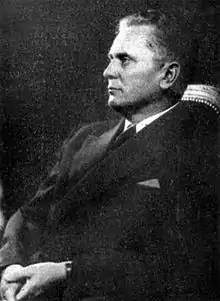
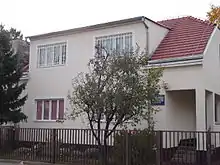
Tito spent 1937 and early 1938 in Yugoslavia organising the KPJ there as a disciplined covert organisation drawing new members loyal to the Communist ideas and Tito personally from all nations within Yugoslavia, except Macedonians.[39] During this period, Tito intervened in conflict among groups of KPJ members incarcerated in Sremska Mitrovica. The conflict centred on the popular front strategy advocated by Hebrang and supported by Moša Pijade, Josip Kraš, and Đuro Pucar and denounced by Petko Miletić backed by Milovan Đilas and Aleksandar Ranković – the latter labelled Wahhabites by Pijade because of their radicalism. The conflict escalated to an attempt to kill Hebrang.[40] Tito worked with Pijade to arrange a compromise by including Đilas and Ranković in the temporary KPJ leadership along with Croatian moderate popular front supporters Kraš and Andrija Žaja as well as Soviet-educated Slovene Edvard Kardelj.[41]
In 1937, the Comintern compelled the KPJ to formally establish the Communist Party of Croatia (Komunistička partija Hrvatske, KPH) and the Communist Party of Slovenia (Komunistična partija Slovenije). The two parties were nominally independent, but actually within the KPJ.[41] This was later the precedent for establishment of communist parties in other parts of Yugoslavia.[21] Still the KPH leadership headed by Kraš and Žaja came into conflict with Tito in 1938 when the KPH supported the HSS instead of the Party of the Working People as the KPJ front founded for participation in 1938 parliamentary elections.[42]
The temporary leadership put together by Tito remained largely unchanged when Tito received the Comintern mandate to lead the KPJ in 1939. Miletić was released from prison that year and sought to replace Tito. Months later he disappeared after he was summoned to Moscow and arrested by the NKVD as a victim of a series of purges in the KPJ in 1937–1940 which strengthened Tito’s position.[43]
In 1940, the KPJ successfully completed the campaign to diminish influence of Krleža and his literary adherents who were advocating Marxist ideas and opposed Stalinisation fearing totalitarianism.[44] Also, Tito removed Kraš and Žaja from the leading positions in the KPH and replaced them by Rade Končar.[45]
In October 1940, the Fifth Land Conference of the KPJ was held covertly in Zagreb, as the final act of Tito’s campaign to assume full control of the party. The conference represented a full takeover of now organisationally stronger, centralized, disciplined, and bolshevized, but politically isolated KPJ by Tito in full alignment with the leftist line pursued by the Comintern at the time.[46] The national question was placed at the centre of the KPJ policy at the conference where Tito criticised long gone Marković and Gorkić for lack of understanding of the issue.[47] As Tito consolidated his control, the KPJ membership grew to 6,000 in 1939 and to 8,000 by 1941, with many more other supporters.[48]
The final months of 1940 were marked by militarisation of politics in Yugoslavia leading to incidents such as the armed clash between the KPJ and the far-right Yugoslav National Movement in October leaving five dead and 120 wounded.[49] The structural changes of the KPJ, strategic use of the national question and social emancipation to mobilise supporters made the party ideologically and operationally ready for armed resistance in the approaching war.[50]
Armed resistance
Setting up the Partisan force

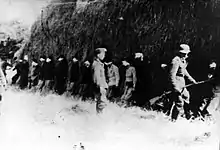
During brief resistance of the Royal Yugoslav Army against the Axis invasion of the country, Tito was in Zagreb. Two days after outbreak of hostilities, the KPJ and the KPH requested arms from the 4th Army headquarters to help defend the city, but they were denied.[51] With the Yugoslav defeat imminent, the KPJ instructed its 8,000 members to stockpile weapons in anticipation of armed resistance,[52] which would spread, by the end of 1941 to all areas of the country except Macedonia.[53]
Building on its experience in clandestine operation across the country, the KPJ proceeded to organise the Yugoslav Partisans,[54] as resistance fighters led by Tito.[55] The KPJ assessed that the German invasion of the Soviet Union had created favourable conditions for an uprising and its politburo founded the Supreme Headquarters of the National Liberation Army of Yugoslavia (Narodonooslobodilačka vojska Jugoslavije) with Tito as commander in chief on 27 June 1941.[56]
In terms of military training, the Partisans relied on those among its ranks who had completed the mandatory national service in the Royal Yugoslav Army or fought in the Spanish Civil War.[57] Many KPJ members were veterans of that conflict,[58] and would go on to assume commanding positions in the Partisan ranks.[59] In addition to military training, political training was given increasing importance as the war progressed. It was provided by political commissars based on the Soviet model.[57] The commissaries were a part of the detachment staff,[60] units originally ranging in size from 50 to 500 or even 1,000.[61] A commissar’s cap badge was made distinct from other Partisans. Namely, the red star on their cap was defaced with the hammer and sickle. The move drew criticism from the Liberation Front of the Slovene Nation (Osvobodilna fronta slovenskega naroda, OF) civil resistance organisation – which accused the KPJ of creating its own army. In response, Slovene Partisan commissars’ caps were adorned with red stars defaced with letters "OF" instead.[62] By 1942, typically 30–50 percent of Partisan unit personnel declared themselves as Communists. Selection of personnel deemed the best for 14 Proletarian Brigades increased this share in those units – to more than 60 percent in some instances.[61] According to Yugoslav sources, the Partisan forces grew to 800,000 by 1945 through volunteers, conscription of men aged 17–50, and defections of enemy troops promised amnesty.[63]
Leftist errors
KPJ’s strategic approach was complex because of pressures from the Comintern prioritising social struggle competing with the national liberation in substantially regionally uneven circumstances resulting from Axis partitioning of Yugoslavia, especially from creation of Axis-satellite of the Independent State of Croatia (Nezavisna Država Hrvatska, NDH).[64]
In Macedonia, the regional organisation led by Metodi Shatorov switched allegiance from the KPJ to the Bulgarian Communist Party, practically recognising Bulgarian annexation of the area.[65] Collapse of Užice Republic, a Partisan-controlled territory in occupied Serbia in 1941 during a German and Chetnik offensive was, in part, helped by views of local peasants who viewed Chetnik propaganda more favourably than Communist social radicalism in light of preservation of their property.[65]
Following the German defeat at Moscow in late 1941, the KPJ leadership thought that the war was nearly over and went to ensure full control by the KPJ in the country. In the period until spring of 1942, this policy was generally confined to Montenegro and eastern Herzegovina, and in a lesser draconian form to the area of present-day Vojvodina and Slovenia. It largely consisted of killing of class enemies where individual Partisan units were given quotas of required executions. It also meant forced labour for peasants deemed idle or even untidy. The targeted populations were driven to support Chetniks or other Axis forces, and the policy thus undermined the overall struggle – in turn causing the KPJ to criticise the perpetrators ignoring their the role of its central committee in formulation of the policy. Similarly, the KPJ penalised Petar Drapšin and Miro Popara as proponents of the policy, but ignored similar roles played by Đilas, Ivan Milutinović, and Boris Kidrič. In spring of 1942, the policy known as the Leftist errors was abandoned.[66]
Conflict of policy in Croatia
Policies employed by the NDH, enforced by the Ustaše against Serbs and ceding of Dalmatia to Italy through the Treaties of Rome created a natural base for Partisan recruitment among the Serbs, and Croats (particularly in Dalmatia) respectively. Furthermore, establishment of the NDH fractured the HSS into three groups – one supporting the armed resistance, another supporting the NDH, and an indecisive group around HSS leader Vladko Maček employing a waiting tactic. In February 1942, the KPH leadership under Hebrang saw this as an opportunity for the Croatian Partisans to wrest the position of the central patriotic force among Croats from the HSS.[67]
In effect, Hebrang thus pursued a policy close to the wartime Soviet coalitionist views, supporting a certain level of involvement of the former members of the HSS, and the Independent Democratic Party, as well as representatives of associations and trade unions in the political life as a form of a "mass movement", including in the work of the State Anti-fascist Council for the National Liberation of Croatia as the top tier political body intended to grow into the future People’s Parliament of Croatia.[68]
Furthermore, Hebrang declared support for a more moderate social policies,[69] and advocated Croatia’s autonomy within the Yugoslav federation.[70] He argued that Serbs of Croatia should be primarily loyal to the Croatian federal unit which would ensure their political representation and preservation of their culture.[71] Nonetheless, the increased Croatian character of the KPH caused anxiety among the Serbs.[72] The independent policy pursued by the KPH brought Tito and Hebrang into conflict with pursuit of nationalist policy as the principal charge against the KPH. Due Hebrang's popularity, the KPJ wanted to avoid antagonising Croats during the wartime struggle and instead, just two weeks before the Red Army and the Partisans took the capital from Germans, reassigned Hebrang to Belgrade to become the minister of industry and filled the leading role in the KPH with Vladimir Bakarić.[73]
Proclamation of new government
In November 1942, the Partisans captured the town of Bihać and secured control over a large part of western Bosnia, Dalmatia and Lika they named the Bihać Republic.[74] In the town, an pan-Yugoslav assembly – the Anti-Fascist Council for the National Liberation of Yugoslavia (Antifašističko vijeće narodnog oslobođenja Jugoslavije, AVNOJ) – was established in the at the town initiative of Tito and the KPJ later that month. At its founding meeting, the AVNOJ adopted the principle of federal state as the solution for future.[75] In the wake of the Bihać meeting, there were land councils established as political bodies representative of individual parts of the future federation.[76]
The AVNOJ convened for the second time in Jajce in November 1943, declaring itself as the future parliament of the new Yugoslav state, affirmed commitment to forming a democratic federation without specifying any details of such federation. It also denied authority of the Yugoslav government-in-exile and forbade the King Peter II return to the country.[77] A month before the Jajce meeting, the central committee of the KPJ created the National Committee for the Liberation of Yugoslavia as the new Yugoslav government,[78] and the AVNOJ confirmed its composition – including Tito as its president.[79] Tito's position was reinforced through the Tito–Šubašić Agreements he concluded with the government-in-exile in the second half of 1944 and early 1945. On the basis of those agreements, the government-in-exile was replaced with the Provisional Government of the Democratic Federal Yugoslavia with Tito as the Prime Minister on 7 March 1945.[80]
During the war, the KPJ added new organisations based on foreseen federal units. In 1943, it established the Communist Party of Macedonia (Комунистичка партија на Македонија) and, in the final days of the war in May 1945, the KPJ founded the Communist Party of Serbia (Komunistička partija Srbije / Комунистичка партија Србије).[81] By the end of the war, the KPJ’s membership reached just over 141,000.[82]
Post-war consolidation of power
Drift to the one-party system

In 1945, the KPJ worked to broaden its support, and discredit its political opponents.[83] Since the politicians included in the government-in-exile only returned to Yugoslavia in March 1945, and Vladko Maček remained abroad, there was no well-organised political opposition to the KPJ.[84] The People's Front of Yugoslavia (Narodni front Jugoslavije, NFJ) was established in autumn of 1945, nominally a coalition of nearly all political parties in the country. A notable exception was Milan Grol's Democratic Party which was charged with the Serbian nationalism. Besides the KPJ, the NFJ included weak and poorly organised bourgeois parties: the Yugoslav Republican Party, the Independent Democratic Party, the Agriculturalist’s Union, the Socialist Party, the JSDS, the HSS, and a group of politicians organised as the Forward (Napred) group.[85] While non-Communist parties in the NFJ hoped for equality, Tito primary saw the NFJ as a tool for neutralization of political opposition by allying them with the KPJ.[84] Due to weakness of the non-Communist parties in the NFJ, the KPJ dominated the group.[85]
In preparation of the 1945 elections, the AVNOJ was expanded by addition of pre-war members of parliament deemed not compromised by cooperation with the Axis powers. In effect, this meant addition of liberal and left-leaning politicians who could not be accused of collaborating with the Axis.[86] Civil rights were curbed in the summer of 1945 when new legislation on crimes against the people and the state, curtailing the rights of assembly and freedom of the press. Middle and lower levels of bureaucracy were filled with the ranks of former Partisans.[87]
Following a boycott proclamation by the Grol's Democrats, the elections were carried out like a referendum–voting for the NFJ and against it. The NFJ slate received the highest approval in Croatia where the HSS was aligned with the KPJ (81%), followed by Slovenia (78%) despite non-participation by the pre-war parties in the NFJ slate there, and the lowest support in Serbia (67%). This result is attributed to monarchism and the boycott. Ultimately, 88,43% of the electorate voted, and the NFJ was supported by 88,69% of the votes cast. The suffrage was universal for everyone over the age of 18 (including women for the first time), except those charged with Axis collaboration. Former Partisans could vote even if under 18.[88] The KPJ received 404 representatives of 524 (77%) in the bicameral Constituent Assembly.[89]
According to Đilas and Vladimir Velebit, the KPJ expected to win a majority of 60–65% even if the election were to guarantee fair competition. They based the opinion on the belief that the KPJ offered the opportunity to live in peace, an agrarian reform, and on post-war euphoria.[90] In 1946, the parliament adopted a new Constitution implementing the ethnic federalism as the KPJ's solution for the national question,[91] modelled on the Soviet Union.[70] By 1947, the KPJ declared that its programme was the NFJ's programme and that the KPJ is in the forefront of the NFJ. Tito linked the collapse of the pre-war Yugoslavia with the multi-party system of government, justifying suppression of political opposition parties in the post-war context–calling the multi-party system incompatible with the socialist order and unnecessary.[92] In October 1948, the four existing republican communist parties were complemented by two more: the Communist Party of Bosnia and Herzegovina,[93] and the Communist Party of Montenegro.[94]
Break with the Soviet Union
Objectives of the Soviet foreign policy gradually brought the USSR in conflict with the KPJ. Their relationship was complicated as the KPJ led armed resistance against the Axis while the Soviet foreign relations re initially constrained by provisions of the Molotov–Ribbentrop Pact,[95] and then with alliance with the Western Allies who supported the Yugoslav government-in exile until shortly after the initial Tito–Šubašić Agreement.[96] As Yugoslavia was not fully in the Soviet post-war sphere of influence,[96] Tito pursued a foreign policy course seeking to integrate Albania into the Yugoslav federation, support the Greek communist guerrillas,[97] and broaden ties between Yugoslavia and Bulgaria–potentially unifying the countries. Conclusion of the 1947 Bled Agreement seeking closer ties with Bulgaria,[98] and imminent deployment of Yugoslav Army to Albania prompted a political confrontation with the USSR.[99] The Tito–Stalin split was culmination of the clash when the KPJ was expelled from the Cominform in 1948. For political reasons, the rift was presented as ideological rather than geopolitical one.[100] The KPJ initially reacted to Stalin's criticism by adopting corrective measures in the field field of collectivisation described as more Stalinist than those employed by Stalin himself.[101]
The KPJ saw purges of real or perceived Stalin supporters and other political opponents of the regime.[102] In 1948–1951 period, more than 50,000 KPJ members (nearly 20% of its membership) were registered as political opponents and ejected, but the party expanded its ranks by including more than a half a million of new members in the same time-frame.[103] Virtually all parties within the NFJ or otherwise were dismantled following the Stalin letters in which the Soviet leader accused the KPJ of being diluted by the NFJ. The only exception was the HSS, whose operation was allowed to continue temporarily.[104] The exact number of those arrested remains uncertain, but in 1983, Radovan Radonjić stated that 16,288 were arrested and convicted, including 2,616 belonging to various levels of the KPJ leadership.[103] According to Ranković, 51,000 people were killed, imprisoned or sent to forced labour.[105] A majority of them were sentenced without a trial.[106] Prisoners were held at numerous sites, including a special-purpose prison camp built on the uninhabited Adriatic islands of Goli Otok and Sveti Grgur in 1949.[107]
In view of the circumstances and the ideological aspect of the Yugoslav–Soviet split, the KPJ found it necessary to differentiate the Yugoslav political system from the Soviet one. Since the KPJ labelled the USSR undemocratic, it was necessary to devise and highlight innovative KPJ’s approach to the communist rule.[108] This was pursued through the workers' self-management introduced in legislation in 1950, as well as through opposition to Stalinism and inter-war Yugoslav unitarism.[109] The approach led to a period of ideological revisionism where established doctrines were open to questioning.[110]
Reform and conflict with Đilas
Even though Soviet and Cominform propaganda drew attention to inequalities in the economic development of various parts of Yugoslavia alleging restoration of capitalism, and national oppression of the underdeveloped nations,[111] the clash between strict centralisation and decentralisation appeared as a conflict between the political principle and economic priorities.[112] In 1950, Yugoslav authorities sought to combat unsustainable labour practices and improve production efficiency through introduction of workers' councils and the system which later became known as "self-management".[113]
However, the 1946 Yugoslav constitution followed the model of the Soviet federation where the federal parliament legislates laws applicable in the federal units and has the power to overrule federal units’ legislation.[114] In 1952, Kardelj drafted constitutional amendments to reflect the reality of the reforms of 1950–1951.[115] This led to codification of the reforms as 1953 Yugoslav constitutional amendments seeking to reflect the economic power of each constituent republic, while ensuring equal representation of each federal unit in the assembly to counterbalance this.[116]
The KPJ proclaimed shift from party monopolising power to the ideological leader of the society, decentralised its structure, and rebranded itself (and correspondingly its republican organisations) as the League of Communists of Yugoslavia (Savez komunista Jugoslavije, SKJ) at its sixth congress held in Zagreb in 1952.[117] The constitutional amendments, adopted in January 1953, were only the second step in a series of five constitutional reforms reflecting the social development of Communist-ruled Yugoslavia, but the principles introduced in 1953 were retained in all subsequent Yugoslav constitutions.[118]
After the Yugoslav rapprochement with the USSR, Đilas feared Yugoslavia would switch to full control of the society by the central government. He thought that was possible due to influence of Ranković–the Đilas's primary competitor as a potential successor to Tito. Đilas wrote a series of articles for Borba criticising bureaucratism and Communist exclusive claim to power. He took the criticism further in a compilation of essays, accusing the KPJ of elitism and enjoying of privileges. In response, Đilas was removed from the KPJ central committee in January 1954 and soon he left the KPJ. In a subsequent The New York Times interview, he called for a multi-party system in Yugoslavia–and this led to his imprisonment. Đilas was pardoned in 1966.[119]
Yugoslavism campaign
At the 7th Congress of the SKJ held in 1958, the party became more centralised. This was achieved by largelly revoking decision-making powers previously given to republican branches of the SKJ. The party programme published at the Congress praised emerging Yugoslav consciousness and a series of articles was published advocating creation of unified Yugoslav culture. This decision built on introduction of the option of declaring one's ethnicity as Yugoslav in the 1953 census,[120] and the régime-sponsored 1954 Novi Sad Agreement on the single Serbo-Croatian language.[121] Thus launched Yugoslavism campaign sought to replace federalism with unitarism.[122] Ranković became the most prominent advocate of the campaign. He sought support from the League of Communists of Bosnia and Herzegovina (Savez komunista Bosne i Hercegovine, SKBiH) and from the League of Communists of Montenegro (Savez komunista Crne Gore, SKCG) – with some success in the latter. In 1963, Serbia and Montenegro concluded several agreements on strengthening economic and cultural ties, including construction of the Belgrade–Bar railway.[122]
The campaign was publicly criticised through an exchange of letters published in Borba. The proponents of the campaign, largely ethnic Serbs, were accused of scheming to abolish republics and resurrect Greater Serbian chauvinism.[123] Particular opposition came from the League of Communists of Croatia (Savez komunista Hrvatske, SKH) and the League of Communists of Macedonia (Сојуз на комунистите на Македонија, SKM). They were joined in an informal national-liberal coalition by the League of Communists of Slovenia (Zveza komunistov Slovenije, ZKS) and, in a less prominent role, by the leadership of Vojvodina.[124] In early 1963, Tito was compelled to publicly warn about chauvinism and reassure non-Serbs that merger of nations was not contemplated while defending the concept of Yugoslavism. Finally, at the 8th Congress of the SKJ held in 1964, Tito and Kardelj gave speeches criticising those thinking about merging nations of Yugoslavia as proponents of bureaucratic centralisation, unitarism and hegemony. There was no further mention of Yugoslavism at the Congress and the republican branches of the SKJ were given back their decision-making powers to reflect specificities and national character of the republics.[123] The 8th Congress thus abandoned Yugoslavism in favour of decentralisation.[125]
The SKJ promoted the notion of "Yugoslav socialist patriotism". The concept was described by its advocates as the feeling or awareness and love of the socialist self-management community. According to the SKJ, the concept was unrelated to nationalism and ethnicity. The notion was also claimed to support values and traditions of ethnic groups living in Yugoslavia.[126]
Rise and fall of liberalism
In the 1960s, the centralized command structure of the League of Communists began to be dismantled with the fall of the hardline OZNA and UDBA chief Aleksandar Ranković in 1966,[127] culminating in the social and political movements that would lead to the de-centralized and regionalized Federal Yugoslavia of the Constitution of 1974.
The Communists had a number of dissidents within its ranks:
- Aleksandar Ranković argued for a highly centralized system more akin to the Soviet model and was expelled from the party in 1966.
- In the course of the Croatian spring of 1971, some of the Croatian party members were disciplined due to accusations of liberalism and nationalism, along with Serbian communists accused of liberalism. Many of their ideas were ultimately adopted in the new 1974 Yugoslav Constitution.
- The Praxis School — a Marxist humanist philosophical movement that originated in Zagreb and Belgrade. Its members were critical towards the version of self-management socialism implemented by the LCY and were removed from their university jobs for their views.
| Nationality | Total members | Percent of membership | Percent of total population |
|---|---|---|---|
| Serb | 541,526 | 51.77 | 42.08 |
| Croat | 189,605 | 18.13 | 23.15 |
| Slovene | 70,516 | 6.74 | 8.57 |
| Macedonian | 67,603 | 6.46 | 5.64 |
| Montenegrin | 65,986 | 6.31 | 2.77 |
| Muslim | 37,433 | 3.58 | 5.24 |
| Albanian | 31,780 | 3.04 | 4.93 |
| Hungarian | 12,683 | 1.21 | 2.72 |
| Others | 28,886 | 2.76 | 4.90 |
| Total | 1,046,018 | 100.00 | 100.00 |
Decline and dissolution
After Tito's death in 1980 the party adopted a collective leadership model, with the party presidency rotating annually. The party's influence declined and the party moved to a federal structure giving more power to party branches in Yugoslavia's constituent republics. Party membership continued to grow reaching two million in the mid-1980s but membership was considered less prestigious than in the past.
Slobodan Milošević became President of the League of Communists of Serbia in 1987 and combined certain Serbian nationalist ideologies with opposition to liberal reforms. The growing rift among the branches of the Communist Party and their respective republics came to a head at the LCY's 14th Congress, held in January 1990. The LCY renounced its monopoly of power, and agreed to allow opposition parties to take part in elections. However, rifts between Serbian and Slovenian Communists led the LCY to dissolve into different parties for each republic.[129]
The Communist associations in each republic shortly changed their names to Socialist or Social-Democratic parties, transmuting into movements which were left-oriented, but no longer strictly communist.
The remnants of the local branches were transformed:
- the League of Communists of Serbia in 1990 into the Socialist Party of Serbia
- the League of Communists of Croatia in 1990 into the Party of Democratic Changes of Croatia (later merged in 1994 with the Social Democrats of Croatia and renamed party to Social Democratic Party of Croatia)
- the League of Communists of Macedonia in 1990 into the Social Democratic Union of Macedonia
- the League of Communists of Slovenia in 1990 into the Party of Democratic Reforms of Slovenia (in 1993 with smaller extra-parliamentary parties to become the United List of Social Democrats, renamed to Social Democrats in 2005)
- the League of Communists of Bosnia and Herzegovina in 1991 into the Social Democratic Party of Bosnia and Herzegovina
- the League of Communists of Montenegro in 1991 into the Democratic Party of Socialists of Montenegro
See also
- President of the League of Communists of Yugoslavia – list of party leaders
- League of Communist Youth of Yugoslavia – youth organisation
Notes
- Serbo-Croatian: Савез комуниста Југославије (СКЈ), Savez komunista Jugoslavije (SKJ)
Slovene: Zveza komunistov Jugoslavije
Macedonian: Сојуз на комунистите на Југославија, Sojuz na komunistite na Jugoslavija - Serbo-Croatian: Комунистичка партија Југославије (КПЈ), Komunistička partija Jugoslavije (KPJ)
Slovene: Komunistična partija Jugoslavije
Macedonian: Комунистичка партија на Југославија, Komunistička partija na Jugoslavija
Footnotes
- Gibianskii 2012, p. 230.
- Hoare 2010, p. 112.
- Štiks 2015, pp. 41.
- Engelsfeld 1972, p. 184.
- Engelsfeld 1972, pp. 184–185.
- Banac 1984, p. 329.
- Engelsfeld 1972, p. 187.
- Banac 1988, pp. 46–48.
- Tomasevich 2001, p. 13.
- Banac 1984, p. 338.
- Calic 2019, p. 82.
- Banac 1988, pp. 50–51.
- Calic 2019, p. 114.
- Banac 1984, pp. 394–395.
- Lampe 2000, pp. 122–125.
- Tomasevich 2001, p. 16.
- Banac 1988, p. 51.
- Banac 1984, pp. 328–329.
- Tomasevich 2001, pp. 20–21.
- Banac 1988, p. 53.
- Burg 2014, p. 20.
- Banac 1988, pp. 51–52.
- Banac 1988, p. 55.
- Banac 1988, pp. 57–59.
- Štiks 2015, pp. 44.
- Banac 1988, pp. 58–59.
- Hoare 2011, p. 204.
- Banac 1988, p. 59.
- Banac 1988, p. 60.
- Lampe 2000, p. 174.
- Banac 1988, p. 61.
- Banac 1988, pp. 61–62.
- Glenny 2012, p. 434.
- Tomasevich 2001, p. 37.
- Banac 1988, pp. 63–65.
- Štiks 2015, pp. 46–47.
- Banac 1988, p. 65.
- Banac 1988, p. 67.
- Burg 2014, pp. 20–21.
- Banac 1988, pp. 65–67.
- Banac 1988, p. 68.
- Banac 1988, pp. 74–76.
- Banac 1988, pp. 68–70.
- Banac 1988, pp. 71–74.
- Banac 1988, pp. 75–76.
- Banac 1988, pp. 77–78.
- Štiks 2015, p. 47.
- Lampe 2000, p. 196.
- Calic 2019, pp. 116–117.
- Štiks 2015, pp. 47–48.
- Tomasevich 2001, p. 52.
- Vukšić 2003, p. 10.
- Tomasevich 2001, p. 88.
- Vukšić 2003, pp. 13–15.
- Ramet 2006, p. 113.
- Vukšić 2003, pp. 10–11.
- Vukšić 2003, p. 19.
- Calic 2019, p. 116.
- Calic 2019, p. 135.
- Vukšić 2003, p. 26.
- Vukšić 2003, p. 17.
- Vukšić 2003, pp. 57–58.
- Calic 2019, p. 154.
- Banac 1988, pp. 78–79.
- Banac 1988, p. 79.
- Banac 1988, pp. 81–83.
- Banac 1988, pp. 84–85.
- Banac 1988, pp. 84–86.
- Banac 1988, p. 87.
- Irvine 2007, pp. 154–155.
- Banac 1988, pp. 94–95.
- Banac 1988, p. 93.
- Banac 1988, pp. 96–98.
- Calic 2019, p. 138.
- Lukic & Lynch 1996, pp. 71–72.
- Banac 1988, pp. 99–100.
- Hoare 2013, pp. 181–183.
- Hoare 2013, p. 166.
- Hoare 2013, p. 185.
- Roberts 1973, pp. 316–317.
- Banac 1988, p. 110.
- McClellan 1969, p. 124.
- Lilly 1994, p. 398.
- Calic 2019, p. 162.
- Flere & Klanjšek 2019, p. 59.
- Flere & Klanjšek 2019, p. 56.
- Calic 2019, p. 163.
- Flere & Klanjšek 2019, pp. 59–60.
- Radelić 2016, p. 31.
- Flere & Klanjšek 2019, p. 60.
- Rusinow 2007, p. 131.
- Flere & Klanjšek 2019, pp. 61–62.
- Hoare 2013, p. 368.
- Banac 1988, p. 165.
- Banac 1988, pp. 4–5.
- Murray 2019, pp. 154–155.
- Perović 2007, pp. 45–49.
- Banac 1988, p. 41.
- Perović 2007, pp. 50–52.
- Perović 2007, pp. 52–62.
- Bokovoy 1998, pp. 86–87.
- Perović 2007, pp. 58–61.
- Banac 1988, pp. 148–151.
- Flere & Klanjšek 2019, p. 61.
- Woodward 1995, p. 180, note 37.
- Banac 1988, p. 148.
- Banac 1988, pp. 247–248.
- Haug 2012, p. 138.
- Haug 2012, p. 137.
- Banac 1988, p. 139.
- Banac 1988, p. 174.
- Woodward 1995, p. 130.
- Woodward 1995, p. 151.
- Đilas 1991, pp. 159–160.
- Woodward 1995, p. 180.
- Woodward 1995, p. 184.
- Woodward 1995, p. 182.
- Woodward 1995, p. 164.
- Calic 2019, pp. 181–182.
- Connor 1984, p. 436.
- Rusinow 2003, p. 19.
- Ramet 2006, p. 216.
- Connor 1984, pp. 436–439.
- Ramet 2006, pp. 216–217.
- Štiks 2015, pp. 92–93.
- Ramet 1995, p. 207.
- TIme, 7 February 1972.
- Vucinich 1969, p. 256.
- Tempest 1990.
References
Books
- Banac, Ivo (1984). The National Question in Yugoslavia: Origins, History, Politics. Ithaca, New York: Cornell University Press. ISBN 0-8014-1675-2.
- Banac, Ivo (1988). With Stalin against Tito: Cominformist Splits in Yugoslav Communism. Ithaca, New York: Cornell University Press. ISBN 0-8014-2186-1.
- Bokovoy, Melissa Katherine (1998). Peasants and Communists: Politics and Ideology in the Yugoslav Countryside, 1941-1953. Pittsburgh, Pennsylvania: University of Pittsburgh Press. ISBN 9780822940616.
- Burg, Steven L. (2014). Conflict and Cohesion in Socialist Yugoslavia: Political Decision Making Since 1966. Princeton, New Jersey: Princeton University Press. ISBN 9781400853373.
- Calic, Marie-Janine (2019). A History of Yugoslavia. West Lafayette, Indiana: Purdue University Press. ISBN 978-1-55753-838-3.
- Connor, Walker (1984). The National Question in Marxist-Leninist Theory and Strategy. Princeton, New Jersey: Princeton University Press. ISBN 0-691-07655-3.
- Đilas, Aleksa (1991). The Contested Country: Yugoslav Unity and Communist Revolution, 1919-1953. Cambridge, Massachusetts: Harvard University Press. ISBN 9780674166981.
- Flere, Sergej; Klanjšek, Rudi (2019). The Rise and Fall of Socialist Yugoslavia: Elite Nationalism and the Collapse of a Federation. Lanham, Maryland: Rowman & Littlefield. ISBN 9781498541978.
- Gibianskii, Leonid (2012). "Communist Party in Yugoslavia". In Pons, Silvio; Service, Robert (eds.). A Dictionary of 20th-Century Communism. Princeton, New Jersey: Princeton University Press. pp. 230–233. ISBN 9780691154299.
- Glenny, Misha (2012). The Balkans, 1804–2012: Nationalism, War and the Great Powers. Toronto, Ontario: House of Anansi Press. ISBN 978-1-77089-273-6.
- Haug, Hilde Katrine (2012). Creating a Socialist Yugoslavia: Tito, Communist Leadership and the National Question. London, UK: Bloomsbury Publishing. ISBN 9780857721211.
- Hoare, Marko Attila (2010). "The War of Yugoslav Succession". In Ramet, Sabrina P. (ed.). Central and Southeast European Politics since 1989. Cambridge, UK: Cambridge University Press. pp. 111–136. ISBN 978-0-521-88810-3.
- Hoare, Marko Attila (2013). The Bosnian Muslims in the Second World War. Oxford, UK: Oxford University Press. ISBN 978-0-231-70394-9.
- Irvine, Jill (2007). "The Croatian Spring and the Dissolution of Yugoslavia". In Cohen, Lenard J.; Dragović-Soso, Jasna (eds.). State Collapse in South-Eastern Europe: New Perspectives on Yugoslavia's Disintegration. West Lafayette, Indiana: Purdue University Press. pp. 149–178. ISBN 978-1-55753-461-3.
- Lampe, John R. (2000). Yugoslavia as History: Twice There Was a Country (2nd ed.). Cambridge, UK: Cambridge University Press. ISBN 0-521-77357-1.
- Lukic, Renéo; Lynch, Allen (1996). Europe from the Balkans to the Urals: The Disintegration of Yugoslavia and the Soviet Union. Stockholm, Sweden: SIPRI. ISBN 9780198292005.
- McClellan, Woodford (1969). "Postwar Political Evolution". In Vucinich, Wayne S. (ed.). Contemporary Yugoslavia: Twenty Years of Socialist Experiment. Berkeley, California: University of California Press. pp. 119–153. ISBN 9780520331105.
- Murray, Chris (2019). "From resistance to revolution: occupied Yugoslavia". In Murray, Chris (ed.). Unknown Conflicts of the Second World War: Forgotten Fronts. Oxon, UK: Routledge. pp. 139–170. ISBN 978-1-138-61294-5.
- Radelić, Zdenko (2016). "The Communist Party of Yugoslavia and the Abolition of the Multi-party System: The Case of Croatia". In Ognjenović, Gorana; Jozelić, Jasna (eds.). Revolutionary Totalitarianism, Pragmatic Socialism, Transition: Volume One, Tito's Yugoslavia, Stories Untold. New York City, New York: Springer Nature. ISBN 978-1-137-59742-7.
- Ramet, Sabrina P. (1995). Social Currents in Eastern Europe: The Sources and Consequences of the Great Transformation. Durham, North Carolina: Duke University Press. ISBN 9780822315483.
- Ramet, Sabrina P. (2006). The Three Yugoslavias: State-building and Legitimation, 1918–2005. Bloomington, Indiana: Indiana University Press. ISBN 9780253346568.
- Rakowska-Harmstone, Teresa (1984). Communism in Eastern Europe. Bloomington, Indiana: Indiana University Press. ISBN 9780253313911.
- Roberts, Walter R. (1973). Tito, Mihailović, and the Allies, 1941-1945. New Brunswick, New Jersey: Rutgers University Press. ISBN 978-0-8135-0740-8.
- Rusinow, Dennison (2003). "The Yugoslav Idea before Yugoslavia". In Djokic, Dejan (ed.). Yugoslavism: Histories of a Failed Idea, 1918-1992. London, UK: C. Hurst & Co. pp. 11–26. ISBN 1-85065-663-0.
- Rusinow, Dennison (2007). "Reopening of the "National Question" in the 1960s". In Cohen, Lenard J.; Dragović-Soso, Jasna (eds.). State Collapse in South-Eastern Europe: New Perspectives on Yugoslavia's Disintegration. West Lafayette, Indiana: Purdue University Press. pp. 131–148. ISBN 978-1-55753-461-3.
- Štiks, Igor (2015). Nations and Citizens in Yugoslavia and the Post-Yugoslav States: One Hundred Years of Citizenship. London, UK: Bloomsbury Publishing. ISBN 978-1-4742-2152-8.
- Tomasevich, Jozo (2001). War and Revolution in Yugoslavia, 1941–1945: Occupation and Collaboration. Stanford, California: Stanford University Press. ISBN 978-0-8047-0857-9.
- Vucinich, Wayne S. (1969). "Nationalism and Communism". In Vucinich, Wayne S. (ed.). Contemporary Yugoslavia: Twenty Years of Socialist Experiment. Berkeley, California: University of California Press. pp. 236–284. ISBN 9780520331105.
- Vukšić, Velimir (2003). Tito's Partisans 1941–45. Oxford, UK: Osprey Publishing. ISBN 1-84176-675-5.
- Woodward, Susan L. (1995). Socialist Unemployment: The Political Economy of Yugoslavia, 1945–1990. Princeton, New Jersey: Princeton University Press. ISBN 0-691-08645-1.
Journals
- Engelsfeld, Neda (1972). "Rad kluba komunističkih poslanika u plenumu Ustavotvorne skupštine (u prosincu 1920. i u siječnju 1921.)" [Work of the Communist Delegates' Club in the Constitutional Assembly (in December 1920 and January 1921)]. Radovi : Radovi Zavoda za hrvatsku povijest Filozofskoga fakulteta Sveučilišta u Zagrebu (in Croatian). Zagreb, Croatia: University of Zagreb. 2 (1): 181–262. ISSN 0353-295X.
- Lilly, Carol S. (1994). "Problems of Persuasion: Communist Agitation and Propaganda in Post-war Yugoslavia, 1944-1948". Slavic Review. Cambridge, UK: Cambridge University Press. 53 (2): 395–413.
- Perović, Jeronim (2007). "The Tito–Stalin split: a reassessment in light of new evidence". Journal of Cold War Studies. MIT Press. 9 (2): 32–63. doi:10.5167/uzh-62735. ISSN 1520-3972.
Other sources
- "YUGOSLAVIA: The Specter of Separatism". Time. 7 February 1972. Retrieved 12 December 2020.
- Tempest, Rone (23 January 1990). "Communists in Yugoslavia Split Into Factions". Los Angeles Times. Retrieved 12 December 2020.
Further reading
- Lešnik, Avgust (2005). "The development of the communist movement in Yugoslavia during the Comintern Period" (PDF). The international newsletter of communist studies. Bochum, Germany: Ruhr University Bochum. 11 (18): 25–60. ISSN 1862-698X. Archived from the original on 26 August 2017. Retrieved 14 December 2020.
- Swain, Geoffrey (1998). "Tito and the Twilight of the Comintern". In Rees, Tim; Thorpe, Andrew (eds.). International Communism and the Communist International, 1919–43. Manchester, UK: Manchester University Press. pp. 205–224. ISBN 9780719055461.
| Wikimedia Commons has media related to League of Communists of Yugoslavia. |

.svg.png.webp)
